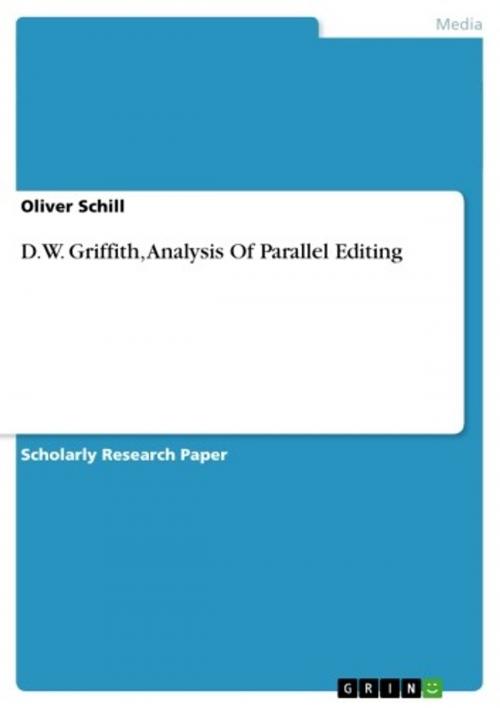| Author: | Oliver Schill | ISBN: | 9783638245227 |
| Publisher: | GRIN Publishing | Publication: | January 14, 2004 |
| Imprint: | GRIN Publishing | Language: | English |
| Author: | Oliver Schill |
| ISBN: | 9783638245227 |
| Publisher: | GRIN Publishing |
| Publication: | January 14, 2004 |
| Imprint: | GRIN Publishing |
| Language: | English |
Research Paper (undergraduate) from the year 2003 in the subject Film Science, grade: A+, Concordia University Montreal (Mel Hoppenhim School For Cinema), course: Montage Aesthethics, language: English, abstract: Before I come to the main analysis of 'A Corner In Wheat' (1909) by D.W. Griffith concerning Parallel and Continuity Editing, I would like to point out one special process of the development of filmmaking, which occurred in the first years since 1895. There by the most interesting part related to the topic of this paper is the development since the middle of the year 1907. At that time 'the production companies began to observe a strict linear time frame '. (Musser, Archeology of the cinema, 1983, page 7) The process took part in mainly two phases. 'First, there was an elimination of retrogressive elements like overlapping action [...] [, for instance] there is rapid cutting between proximate spaces and [...] a strong suggestion of a seamless linear temporality across shot.' (Musser, p.7) Of course this means not yet an establishment of a hole strategies like a match cut on action - at that time there are still used intertitles for example - but it is a kind of development, which made the viewers aware of new possibilities of making films. Especially concerning the movement of time. '[They (the viewers) ] no longer had to wonder if action shown in a given scene occurred before or after a previously shown action' (Musser, p.7). The second phase created 'new representational strategies based on this new form of temporality' (Musser, p.7). In the late 1907 the usage of parallel editing first appeared and got established concerning the linear temporality. Musser mentions the film 'The Runaway Horse' from Pathé, which 'explicitly acknowledged a linear temporality through its use of parallel editing.' Parallel Editing means 'cutting back and forth between two lines of actions' (Musser, p.7). [...]
Research Paper (undergraduate) from the year 2003 in the subject Film Science, grade: A+, Concordia University Montreal (Mel Hoppenhim School For Cinema), course: Montage Aesthethics, language: English, abstract: Before I come to the main analysis of 'A Corner In Wheat' (1909) by D.W. Griffith concerning Parallel and Continuity Editing, I would like to point out one special process of the development of filmmaking, which occurred in the first years since 1895. There by the most interesting part related to the topic of this paper is the development since the middle of the year 1907. At that time 'the production companies began to observe a strict linear time frame '. (Musser, Archeology of the cinema, 1983, page 7) The process took part in mainly two phases. 'First, there was an elimination of retrogressive elements like overlapping action [...] [, for instance] there is rapid cutting between proximate spaces and [...] a strong suggestion of a seamless linear temporality across shot.' (Musser, p.7) Of course this means not yet an establishment of a hole strategies like a match cut on action - at that time there are still used intertitles for example - but it is a kind of development, which made the viewers aware of new possibilities of making films. Especially concerning the movement of time. '[They (the viewers) ] no longer had to wonder if action shown in a given scene occurred before or after a previously shown action' (Musser, p.7). The second phase created 'new representational strategies based on this new form of temporality' (Musser, p.7). In the late 1907 the usage of parallel editing first appeared and got established concerning the linear temporality. Musser mentions the film 'The Runaway Horse' from Pathé, which 'explicitly acknowledged a linear temporality through its use of parallel editing.' Parallel Editing means 'cutting back and forth between two lines of actions' (Musser, p.7). [...]















